Oh deary me, where on earth do I start. There is a story stating that, it was, in fact an Englishman who invented the small kilt, the forerunner of the kilt we wear today. This comes from a letter that was published in a popular pamphlet of the time ‘The Edinburgh Magazine’ in 1785
Now, any Scot reading this is will be sitting thinking, ******** well, let’s just call that a naughty word. Unfortunately this ‘fake news’ is still spoken of today, Jeremy Paxman wrote an article about it in 2014 and an episode of the popular TV quiz show ‘QI’ said that yes indeed the kilt was invented by an Englishman. I actually watched this episode and nearly spat oot ma whisky.
I will let you read what was published in 1785 in ‘The Edinburgh magazine’
“The Felie-beg, no part of the Highland dress. Part of a letter from Ivan Baillie of Aberiachan Esq.”
In answer to your enquiry, I do report, according to the best of my knowledge, and the intelligence of the persons credit, and very advanced ages, that the piece of Highland dress, termed in the Gaelic felie-beg, and in our Scots little kilt, is rather of late than ancient usage.
The upper garment of the Highlanders was the tartan or partly coloured plaid, termed in the Gaelic breccan, when buckled round by a belt, the lower part plaited and the upper loose about the shoulders. The dress termed in Gaelic felie, and in the Scots kilt. It was a cumbersome unwieldly habit to men at work or travelling in a hurry, and the lower class could not afford the expense of belted trousers or breeches. They wore short coats, waistcoats, and shirts of great length as they could afford; such parts as were not covered by these, remained naked to the tying of the garters on their hose.
About 50 years ago, one Thomas Rawlinson, an Englishman, conducted an Iron work carried on in the countries of Glengarie and Lochaber; he had a throng of Highlanders employed in the service, and became very fond of the Highland dress, and wore it in the neatest form; which I can aver, as I became personally acquainted with him above 40 years ago. He was a man of genius and quick parts, and thought it no great stretch of invention to abridge the dress and make it handy and convenient for his workmen: and accordingly directed the using of the lower part plaited of what is called the felie or kilt as above, and the upper part was set aside; and this piece of dress so modelled as a diminutive of the former, was in the Gaelic termed felie-beg (beg in that tongue signifies little) and in our Scots termed little kilt; and it was found so handy and convenient, that, in the shortest space, the use of it became frequent in all the Highland countries, and in many of our Northern low Countries also. This is all I can say about the date and form of the felie-beg, and what was formerly used in place of it. And I certify from my own knowledge, that I returned from Edinburgh to reside in this country in the year 1725, after serving seven or eight years with writers to the signet, I never saw the felie-beg used, nor heard any mention of such a piece of dress, not (even) from my father, who was very intelligent and well known to (acquainted with) Highlanders, and lived to the age of 83 years, and died in the year 1738, born in May 1655.
The felie-beg is in its form and somewhat similar to a woman’s petticoat, termed in the Gaelic boilicoat; but differs in this, that the former is not so long nor sewed in the fore-part, but made to overlap a little. The Great felie or kilt was formed of the plaid double or twofold; the felie-beg, of it single.
I use f and not ph in spelling felie-beg, as in my esteem, more adapted to the Gaelic.
March 22 1768
Well what do you think? it is a very interesting piece and you couldn’t really blame anyone for taking it at face value and thinking that, yes, it does look like an Englishman invented the kilt. However, if you delve deeper you will in fact see that this for what it is, an uninformed tabloid article.
Well I think so. I’ll let you be the judge.
Picture it, Scotland 1769
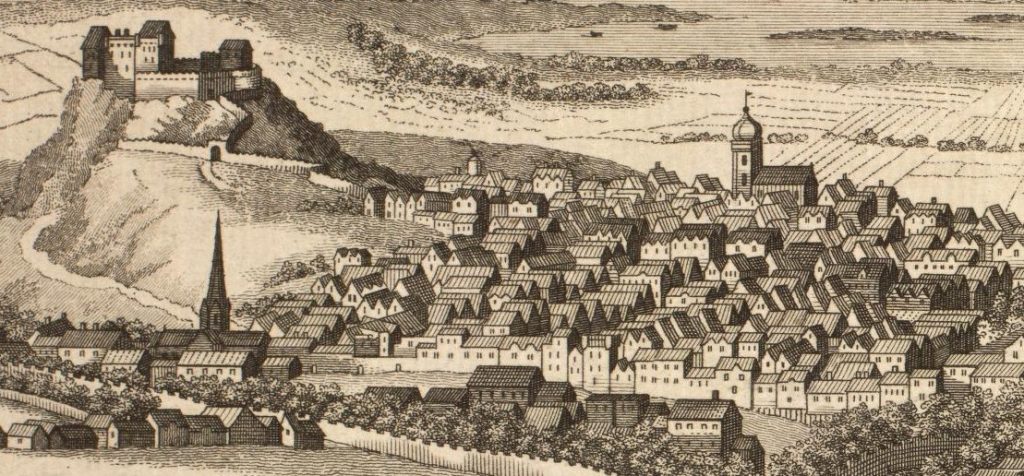
The letter was written by one Ivan (Evan) Baillie to his friend in London in 1769. Ivan was the son of Alexander Baillie of Dochfour and was given the title deeds to Aberiachan (Abriachan), nr Inverness in 1730. There is not much information about him, but I have found, he was not a popular man with his tenants, and was said to have frightened the tenants of Lovat and Belladrum. That tells us a bit about his manner towards the Highlander. According to J.G. Mackay, Evan Baillie was ‘reared and educated as a lowlander, inheriting all the bias and prejudices of his race’ and was quite ignorant of the highland garb. We’re doing well so far.
After the Jacobite campaign of 1715, the government wanted to open up the Highlands and brought in the likes of Edmund Burt (an engineer) and General Wade to build roads systems and bridges which would help with the rise of industrialisation and the exploitation of the land, the attraction being the plentiful supply of coaling wood. Of course, they also thought this would subdue the Jacobites.
The Englishman that is at the centre of all this was an industrialist named Thomas Rawlinson of Whittington, who made a contract with John MacDonnell of Glengarry to establish an Ironworks on his land in March 1727. Ivan was quoted as saying he was his friend of over 40 years. Again there is not much written about either gentleman, but, they probably were acquaintances, even friends.
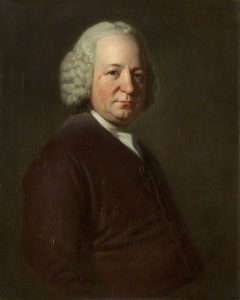
With Rawlinson’s new Ironworks opening in Lochaber, people obviously flocked to the area for work, they came from far and wide, and yes, a lot were indeed Highlanders. The majority of these men would have traditionally worked the land, for which the belted plaid or felie-mor (big kilt) would have been more functional.
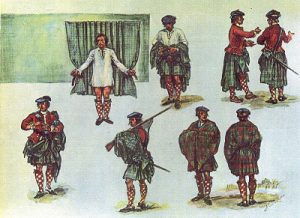
This Felie-mor (big kilt/belted plaid) was made to be a garment by day and blanket by night. The woollen cloth and the amount of it was woven to protect the wearer from the harshness of the land and weather. It was around 2 yards wide and maybe 4- 5 yards in length, worn as the pictures above. The cloth was originally woven on a single width loom so it would only be around 1 yard wide, there was a join in the middle to make it double width. It was designed to be worn in several different ways depending on the situation, a massive join was in the middle and could easily be taken out, for example, if the wearer was now working in a more industrial environment closely with machinery. Ach what am i saying of course us unintelligent Scottish barbarians would have needed an Englishman to tell us this. It would be unthinkable for them there Highland folks, who have worn this most of their lives, and know its construction, to think of it themselves.
Ivan/Evan says ‘and the lower class could not afford the expense of belted trousers or breeches’ mmmmmm I’m not too sure about this as you could probably make 2 or 3 pairs of breeches from the cloth of one belted plaid. Possibly he means the lower class may not have been able to afford ‘his’ personal tailor.
At the same time and in the same area was Edmund Burt, a British military engineer, probably working under General Wade, who was writing letters to a friend in London, that were later published. He talks a lot about the ‘natives’, and not in a nice way which gives us a good insight to how the ‘upper classes’ of the time felt about an ordinary person. Because of this, and like most ex pats around the world, a couple of Englishmen in an unfamiliar country would have gravitated to one another. None of these letters mention this wondrous invention by a fellow Englishman, and believe me after reading some of his letters he would have revelled in this piece of gossip.
Now of course the real piece de resistance ‘The felie-beg is in its form and somewhat similar to a woman’s petticoat,’ This to me sounds like a flowery insult.
The original letter was written during the proscription of Highland dress then published just after the repeal, could it be just another bat to subdue the Highlander, not that they would’ve needed it, it had been 36 years, almost a generation, that the kilt (the garb) had been banned. Many would be use to the lowland clothing by now and I doubt many would’ve reverted back.
My view is simple, the kilt has naturally evolved over the years. It started off as a multi functional garment worn by people working the land, as industrialisation came along and the functions of the garment changed. Some of the cloth would have naturally been shed an in time this cloth would have been sewn, as it is no longer needed as a blanket, and would make it easier to put on.
The yardage of cloth in a kilt has also grown through the ages. Back in the nineteenth century, kilts were commonly only 5 yards and tended to be pleated to a stripe. With the influx of new tartans being woven, the techniques and the abilities of new machinery within larger factories meant that variations of different setts and different sett sizes could be woven and now because of more complex designs more cloth was gradually being introduced and if that’s not enough then came a new form of pleating, in the early 1900s, called pleating the kilt to the sett, which meant the back of the kilt would be the same design as the tartan on the front of the kilt. This became quite popular and because of some of the different complexities of the thread counts in the tartan, this caused the amount of cloth in a kilt to grow until we have the 8 yards that we see today.
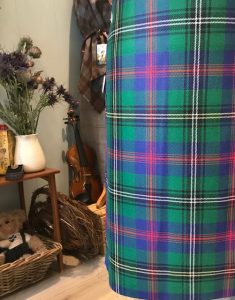
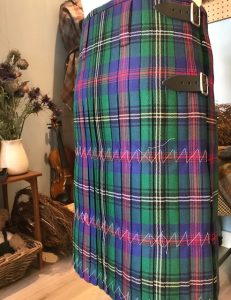
The details we now see on the tailored kilt have also evolved through time, things like the sewn waistband on top. The belt/sporran loops. It is common now to see an extra buckle and strap on the fringe. The kilt is still evolving today as some modern kilts we see today are in different fabrics and have pockets. I’m sure there will be more to come in the next generations that follow us.
Whether you believe the kilt was invented by an Englishman or think, like myself, that it naturally evolved, there is no doubt at all that it is the most stunning garment you will ever see.

When I get home from work today, I can take a pic from an old book of mine showing a portico engraving from the late 1600s, showing short kilts, so Rawlinson probably adopted an extant variant of the kilt that was already in use, for his factories.
Hi, I did want to use this as one of the arguments against the Rawlinson myth as I knew there was evidence of the small kilt before 1720, but couldn’t for the life of me remember where i had seen it. I would love to see the plates. I’m afraid I still find it hard to believe that Rawlinson himself came up with the idea for his factories. The Sobieski Stuart boys are reputed to have said that it was his tailor who come up with the idea, but not really a good source 😉
Nikki
Look up the Arms of Skene and that Ilk, 1672. The images we have of it are of a (now-lost) headboard, though it might be a portico, as Michael Ayling states.
The illustration is of Skene’s coat of arms, detailing, “Dexter, a Highlandman in his proper garb, holding a skene in his right hand in a guarding posture; sinister, another Highlandman in a servile habit, his target on the left arm”.
The Highlander in “proper garb” is wearing the great kilt, as expected, but the one in “servile habit” with a dirk is wearing a little kilt. The original dates to 50 years before Rawlinson’s supposed invention.
Similarly, if you look closely at the portrait of Mungo Murray c. 1683, you can see if you look closely that he’s not wearing a great kilt, as generally assumed, but a little kilt with a shoulder plaid of the same cloth draped dramatically over his shoulder and tucked through his dirk belt, in painterly imitation of a Roman toga. While this image is more debatable, to my eye, it’s still clear pictorial evidence of the little kilt, in an aristocratic context, from well before Rawlinson’s time.
Finally, while Morier’s image of Culloden post-dates the time Rawlinson supposedly invented the kilt by 20 years, there is a social context that makes the Rawlinson tale less likely. Morier is said to have based the Jacobites in the painting on captured prisoners as models, and what they’re wearing is illustrative: great kilts, little kilts, and trews are about equally represented. But it’s also important to recognize that the front ranks of the Jacobite army were not the poorly-armed poor, but the well-armed clan gentry. If the little kilt was invented for poor ironworks laborers a mere two decades prior, why does the garment have such currency among the cream of the crop of Gaelic culture at Culloden?
As far as Trews goes, there’s mixed evidence to its availability. Depending on where you were, they may have been common or uncommon, but would certainly not be prohibitive.
In the Highland Rites and Customes, ~1700, the author writes: “”Their ordinary habit at home is their Trewes and when they goe abroad they use belted playd; and short hose.” It’s usually attributed to James Kirkwood, but Ronald Black (editor of a lot of critical editions of Gaelic works, like John Gregorson Campbell’s Gaelic Otherworld) suggests that Robert Kirk – a collaborator on the first Irish-language Bible published in Roman letters – was the actual author.
Martin Martin, around the same time, writes: “Many of the People wear Trowis: some have them very fine woven like Stockings of those made of Cloth ; some are coloured, and others striped : the latter are as well shap’d as the former, lying close to the Body from the middle downwards, and tied round with a Belt above the Haunches. There is a square Piece of Cloth which hangs down be-fore.”
Burt, also a contemporary, restricts the Trews to the gentry, but IIRC he was based out of the NE Highlands, as opposed to the west coast: “Few besides Gentlemen wear the Trowze, that is, the Breeches and Stock-ings all of one Piece and drawn on together.”
You guys are great, thank you so much. If it is ok with you, I’m going to do a bit more research with this and add into my blog.
🙂
Nikki
Fake Schotten tragen keine Unterwäsche unter dem Kilt !
That’s just like the English. Of course, only THEY were intelligent enough to innovate. And this from and American of mixed Scottish and English ancestry. I claim only the Scottish!